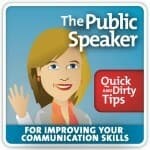Eye contact is in the news again, as interesting new research has caused a small controversy. So when I received an email from Dade, a loyal Public Speaker listener, asking me to talk about building trust through eye contact, I decided it was a topic I needed to explore again.
Over the past few years of this podcast, I’ve talked quite a bit about the importance of good eye contact in public speaking and communication.
In fact, “Tips for Making Eye Contact” and “Common Eye Contact Mistakes” are two of the more popular Public Speaker episodes of all time.
So, when I read about a recent cereal box study involving eye contact, I had to share it with you.
Here’s what happened:
Cornell’s Food and Brand Lab researchers conducted a study using characters on cereal boxes (think Cap’n Crunch, Scooby-Doo, and the Trix Rabbit). They wanted to find out whether the level of eye contact displayed on the cereal boxes evoked trust in the brand. Volunteers were asked to look at different box covers and rate their trust and connection with the brand, and whether they thought it was “attention getting.”
What do you think? Do you think eye contact mattered?
The volunteers most often connected with the box whose character’s eyes were directed at them (rather than downward). When the characters had direct eye contact, study participants viewed the brand as 16% more trustworthy, and viewer’s connection to the brand was 28% higher.
The study also determined that the average angle of gaze of characters on kids’ cereal boxes is slightly downward (a 9.6 angle), while adult cereal characters look almost straight ahead. This suggests that cereal companies are intentionally directing character’s gazes at our children to evoke trust and brand loyalty—this was the controversial part.
This study and the controversy sparked me to think about how important eye contact truly is.
The bottom line is that eye contact is critical to our ability to develop relationships, because eye contact is an important part of building rapport. It lets others know you are interested in them.
Think about how you feel when someone doesn’t acknowledge you with their eyes. Do you feel dismissed? Unimportant?
When delivering a presentation, my general rule is the more eye contact, the better. In fact, you should maintain eye contact at least 90% of the time, and more if possible. It shows confidence, it implies expertise, and it helps build a connection to your audience. However, the rules for eye contact in a conversation are a bit different from the rules for presentations.
Here are four tips for eye contact in conversations:
Tip #1: The Right Amount of Eye Contact Conveys Sincerity
Again, the reason eye contact is so important is that it builds trust between people. In general, many cultures tend to equate eye contact with truthfulness and trustworthiness, and eye avoidance with deceitfulness (think of the child denying he took the last cookie—where is he or she looking?).
Some experts suggest that you should always be sure to note the color of a person’s eyes as a way of helping yourself ensure that you have adequate eye contact.
Tip #2: Be Aware of Individual and Cultural Differences
However, have you ever had a conversation with someone who never looks away? It can be disconcerting.
Too much eye contact during a conversation can make the other person feel uncomfortable. In some cultures (Hispanic, Asian, Middle Eastern, and Native American), too much eye contact can even be perceived as disrespectful or rude.
In most cultures, sustained eye contact (or staring), is considered very rude and can even be used as an intimidating behavior. So what do you do?
Tip #3: Mirror the Other Person’s Eye Contact Frequency
If you sense that the other person is uncomfortable with too much eye contact, then give them breaks by looking away more frequently.
On the other hand, if the other person prefers stronger eye contact (and you will know this because they will maintain your gaze for a while), then you should do the same. The trick is to mirror the other person’s frequency of eye contact to match his or her comfort level.
Tip #4: Read Pupils to Gauge Interest
Finally, another interesting method of ensuring eye contact is to notice the pupils of your conversation partner.
Why?
Eckhard Hess, a scientist who studied pupillometry (the study of why pupils dilate), found that whenever we are interested in someone or something, our pupils dilate to take in more of what we see.
So get into the habit of looking at pupils. This will help you ensure eye contact and also help determine the level of interest in your listener.
The trick with this one is not to stare. Be sure you know the person well enough to create a baseline for comparison. For example, my brother’s pupils are almost always dilated as a side effect of a medical issue.
Eye contact is important for building trust with your conversation partner. Just make sure you’re using the right level of respectful eye contact to let the other person know you are interested in them, and they can be comfortable with you.
More From Quick and Dirty Tips
This article was originally published on Quick and Dirty Tips. It has been republished here with permission.

